Machine Heart reports
In the past year, the advancements in large model technology have been rapid, continually raising the upper limits of model capabilities. However, from the perspective of industrial transformation, the implementation of large models may just be in its initial stages. How to harness the vast potential of large models and drive faster and better transformations in productivity remains a topic rich with exploratory space.
Every industry is concerned with one question: What is the optimal methodology for applying large models at the business level?
When we discuss this question, we naturally cannot avoid “AI Agent”.
As AI transitions from academic frontiers to practical applications, large model-driven agents are becoming the core driving force for innovation. Even Bill Gates predicts that AI Agents will be the future of artificial intelligence. By then, AI Agents will possess planning, execution, perception, memory, and tool usage capabilities, enabling them to autonomously complete tasks while humans assist in setting business goals, providing necessary data and computing resources, and supervising the optimization of work results.
So, where do AI Agents currently stand in various industries? How can their value be maximized?
A recently released white paper provides comprehensive and in-depth answers to the aforementioned questions.
First Systematic Explanation in the Country
How AI Agents Are Implemented in the Automotive Industry?
On April 12, The Natural Language Processing Laboratory of Tsinghua University, Yihui Intelligent, and Mianbi Intelligent jointly released the “White Paper on Large Model-Driven Collective Intelligence Technology in the Automotive Industry.”
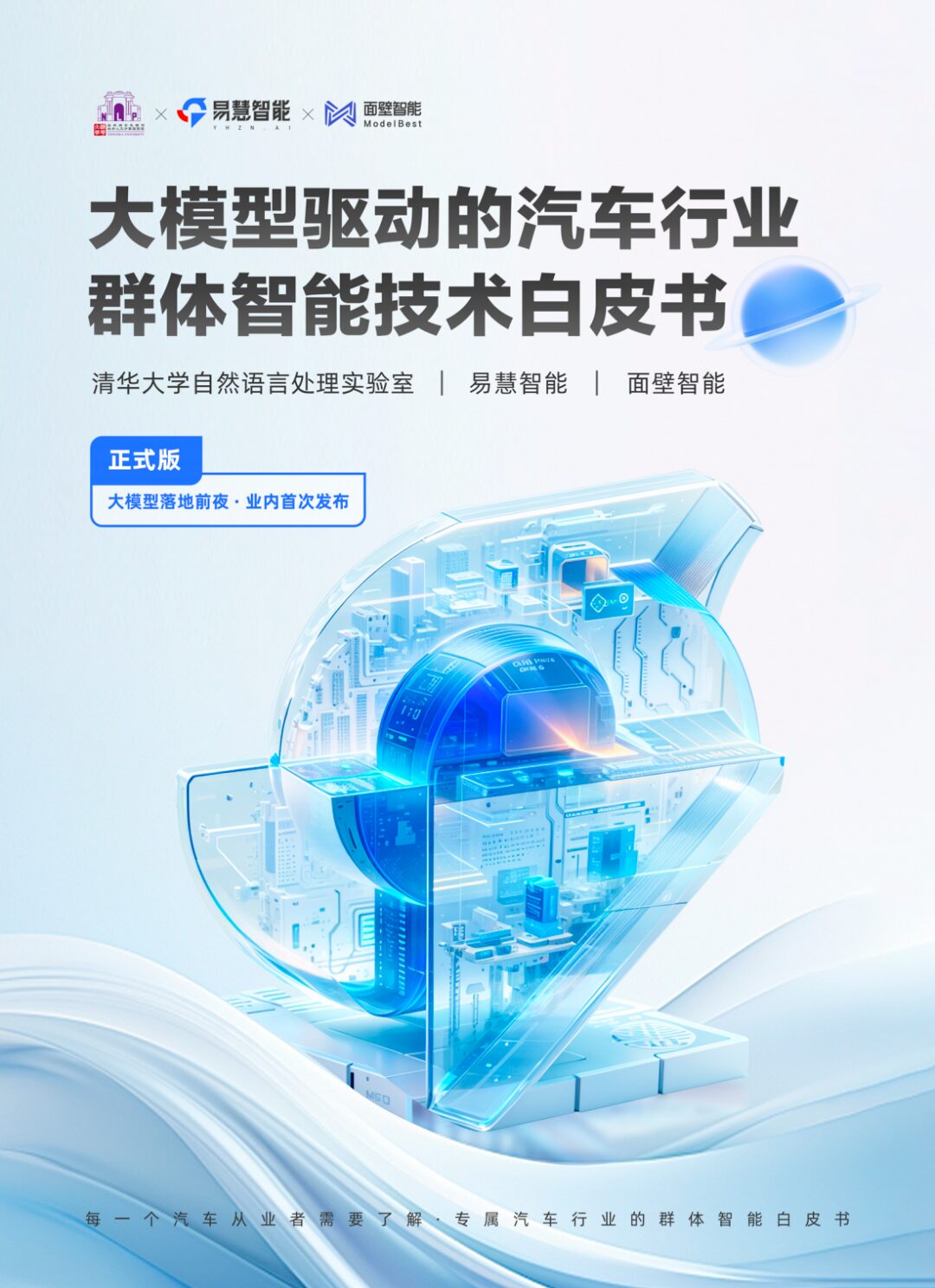
White paper download method: Follow the WeChat official account [Yihui Intelligent] and reply with the keyword “white paper” to download
In recent years, the slowdown in automotive market demand and the improvement in supply efficiency have led to fierce “price wars.” While this benefits consumers, it is a double-edged sword for automotive companies, as they rapidly seize market share while their profit margins are compressed. Finding a solution is a challenge.
The rise of large model technology presents a new opportunity for the intelligent transformation of automotive enterprises. The automotive industry has rich data, clear scenarios, mature technology, high market demand, and intense competition, making it one of the most suitable fields for the implementation of AI Agents.
When the strong demand for transformation meets the historic breakthrough of large model technology, Tsinghua University’s Natural Language Processing Laboratory, Yihui Intelligent, and Mianbi Intelligent decided to collaborate and do something significant to drive change in the automotive industry.
This white paper is the result of the deep “industry-academia-research” cooperation among the three parties.
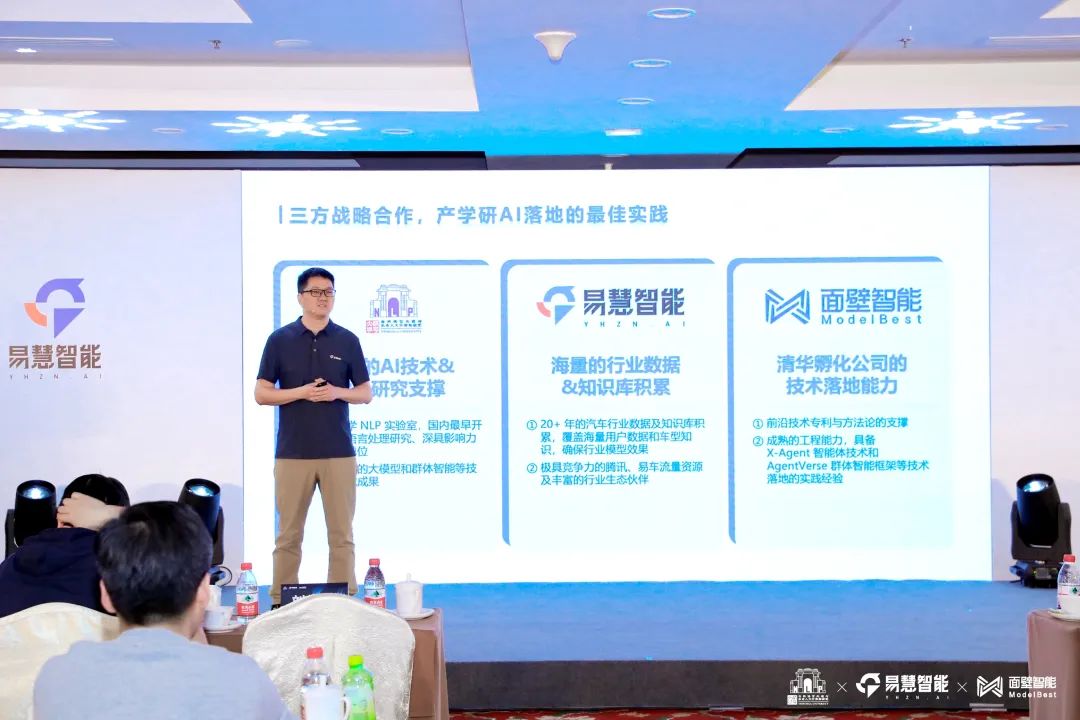
Based on Yihui Intelligent’s deep understanding and resource advantages in automotive application scenarios, combined with Tsinghua University’s NLP laboratory’s advanced collective intelligence theoretical framework, and Mianbi Intelligent’s foundational technologies in large language models and intelligent agents, the three parties aim to build a technical application closed loop covering “large models + AI agents + industry know-how.”
Specifically, the white paper introduces large model-driven collective intelligence technology in an accessible manner and systematically elaborates on the application prospects and practical paths of this technology in the automotive industry for the first time in the industry, particularly proposing systematic solutions aimed at the automotive sector.
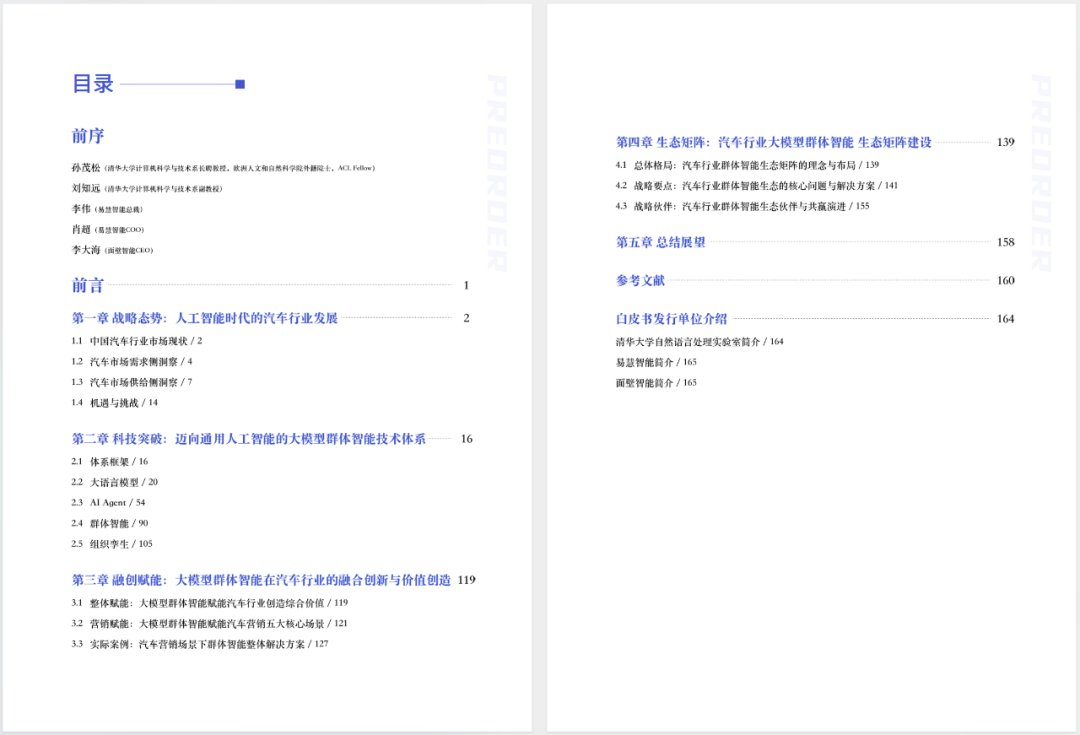
The first chapter provides a comprehensive observation of the current market situation, opportunities, and challenges in the automotive industry; the second chapter delves into the large model collective intelligence technology system, including large language models, AI Agents, collective intelligence, and organizational twins; the third chapter focuses on analyzing the application value and practical cases of large model collective intelligence technology in the automotive industry; the fourth chapter describes the collective intelligence ecological matrix in the automotive industry and its win-win logic in detail; and the fifth chapter looks to the future as a conclusion, emphasizing the importance of these technologies for the transformation and upgrading of the automotive industry.
Analysis of Large Model Collective Intelligence Technology System
In this white paper, we see a keyword that runs throughout: collective intelligence.
The core of AI Agents lies in the interaction between LLM and perception and action. LLM understands the user’s tasks, infers the tools or actions needed, and provides feedback to the user based on the results of the invocation or action.
Most AI Agent applications are implemented in the form of workflows, containing multiple nodes such as large model nodes, code nodes, retrieval nodes, knowledge base nodes, tool nodes, dialogue strategy nodes, etc., and different node combinations are selected to form usable workflows based on different scenarios.
The more familiar concept of AI Agents for most people is singular intelligence—containing only one agent that interacts with the environment independently and optimizes its behavior strategy based on feedback from the environment. However, for many complex scenarios, the capability of a single agent is still limited. On one hand, as the requirements for the knowledge and capabilities of AI Agents increase, the number of prompt words calling the underlying large model increases, and the model’s limited context length cannot accommodate infinitely long prompts; on the other hand, the more content input, the more likely the large model is to experience “forgetting,” meaning it is more likely to follow tail commands while ignoring head commands.
When the number of intelligent agents increases, and their collaborative capabilities improve, forming a complex and powerful collective intelligence system, it can handle more complex tasks and scenario modeling, resulting in a higher level of “intelligent emergence.” The collective intelligence collaboration platform can break down a task, with each segment handled by a specialist, allowing multiple expert agents to work together to achieve work objectives in complex scenarios, significantly expanding the upper limits of intelligent applications and bridging the last mile of enhancing quality and efficiency in industry applications empowered by large models.
However, overall, the development of collective intelligence technology is still in its early stages, and many implementation paths remain to be explored, including how to enhance the adaptability of large models in tool usage and reasoning planning capabilities, enabling them to better fit various tasks and scenarios.
Among them, “industry know-how” becomes the key to realizing the value of Agent implementation. Today, artificial intelligence has surpassed human experts in multiple fields, but upon delving into different sectors, understanding industry terminology, business processes, and requirements remains a key focus for AI Agents to “catch up,” often relying on industry-specific experience.
Collective Intelligence: How Will It Transform Productivity in the Automotive Industry?
After the revolutionary iteration of technology, physical industries typically undergo a profound change. However, regarding AI Agents, there is a consensus among academia, industry, and research: only by deeply understanding the needs and pain points of the industry can we develop AI Agents that truly meet user needs. This is also the original intention behind the birth of this white paper.
In the past few years, discussions on “intelligentization” in the automotive field have mostly revolved around small-scale explorations in the area of autonomous driving. Now, large model collective intelligence technology is rewriting the automotive industry in a revolutionary way, extending the hope of intelligent transformation to all aspects such as complete vehicle manufacturing, supply chain, research and development, engineering, sales and distribution, marketing, after-sales service, trade and logistics, leasing and financial services, and recycling.
How exactly will it transform? The white paper points to five directions: improving enterprise operational efficiency, accelerating process management, enhancing marketing experience, boosting service perception, and increasing enterprise planning capabilities.
For example, from the perspective of enterprise operations, the focus of topics surrounding Agent implementation gradually shifts from “singular intelligence” to “collective intelligence,” giving rise to the concept of “organizational twins,” which includes three key parts: job twins, architecture twins, and business twins. When different roles in each department possess intelligent agents, they can conduct thorough information analysis and transfer among themselves, enabling collaboration and execution, thereby breaking down departmental communication barriers and fully realizing data sharing and business integration.
Additionally, the demand for intelligent transformation in the automotive industry has unique characteristics compared to other industries.
A notable feature is that automotive marketing presents sales difficulties and cycles that other consumer products cannot match, specifically manifested in high customer unit prices, low conversion rates, and long sales lifecycles. After a long period of development, the automotive marketing field has established a standardized, closed-loop methodology. However, in the wave of electrification and intelligentization, the speed of new product launches and iterations continues to accelerate, with fierce end-price competition and increased profitability pressure on traditional channel dealers. Automotive companies need to gain faster insights into user needs and accelerate product development speed, responding more agilely to meet user service demands.
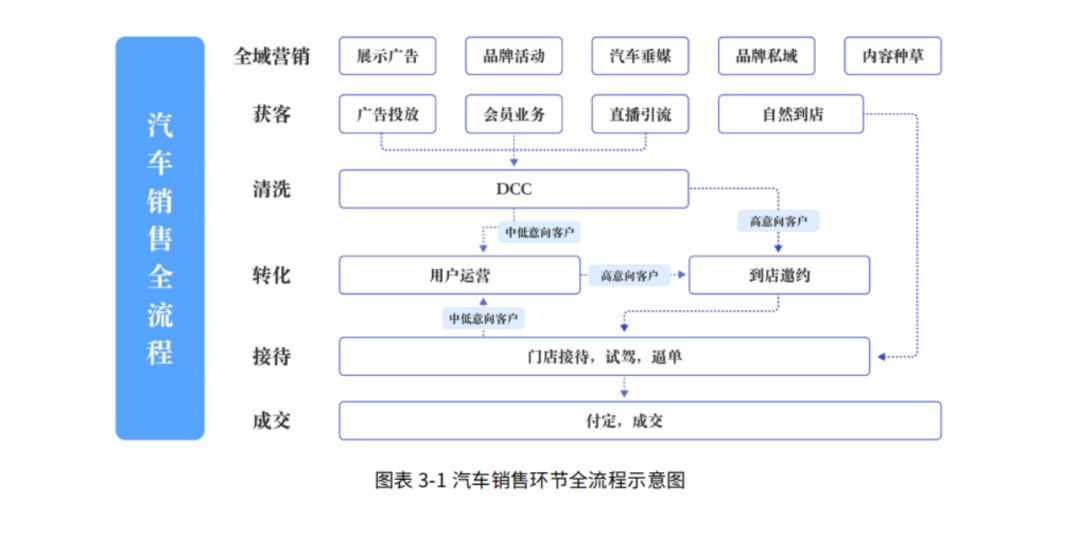
Such scene characteristics provide a highly valuable application space for large model collective intelligence technology.
In the white paper, the three parties combine their unique understanding of the application of AI Agents to realize organizational twins in automotive marketing business based on collective intelligence technology and propose five solutions based on the core scenario growth demands of automotive marketing, including digital intelligence research institute scenario solutions, new media operation scenario solutions, user operation scenario solutions, intensive DDC scenario solutions, and emotional operation scenario solutions.
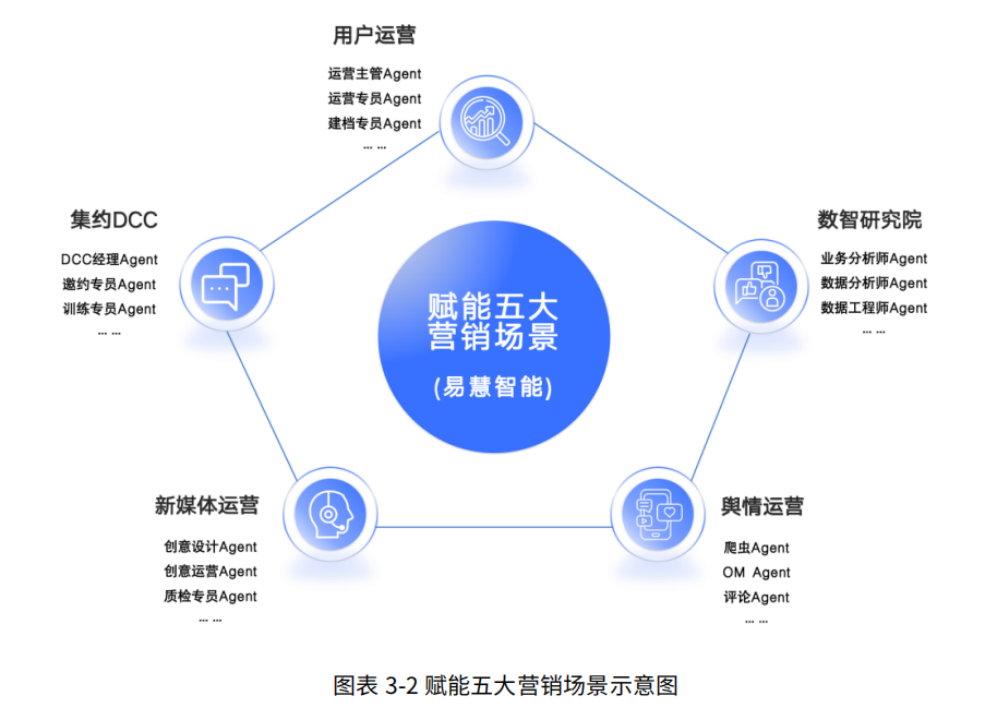
For instance, in the intensive DCC collective intelligence collaboration platform, collective intelligence technology achieves organizational twins for call center customer service. The human-like understanding and instant feedback capabilities of large language models make them ideal tools for solving efficiency loss issues in traditional outbound customer acquisition processes. The model can effectively reduce errors and delays caused by human instability factors by accurately parsing human language and intent, and by constructing a full-process iterative mechanism through digital communication processes.
Moreover, Yihui Intelligent discovered through extensive research and interviews that a large model-based collective intelligence collaboration platform can also support companies in building digital intelligence automotive research centers, developing and deploying digital employee teams that include roles such as data collection, data cleaning, data analysis, and data reporting, efficiently realizing multi-modal data scanning, recognition, classification, analysis, and reporting of user behavior sources, providing more efficient user insights and trend tracking.
The Prelude to an Intelligent Transformation
Although the implementation of AI Agents across various industries is still in the early exploration stage and requires time and technological maturation, the preliminary explorations thus far have shown multiple advantages of collective intelligence technology compared to traditional AI: stronger collaboration capabilities, higher flexibility, and the ability to provide customers with more precise and personalized services.
Professor Liu Zhiyuan from the Department of Computer Science and Technology at Tsinghua University pointed out that China has a strong advantage in rich scenarios and vast markets when exploring the implementation of AI Agents. Both enterprises and individuals are actively exploring various possible methodologies for implementation to maximize value.
In this unprecedented transformation, Yihui Intelligent is one of the pioneers. Based on the YI CPM automotive industry large model, YI Agents digital employee platform, YI Scene business scenario solutions, and other matrix products, Yihui Intelligent is committed to providing leading one-stop solutions for digital employee management and operations to automotive industry clients through large model-driven collective intelligence and organizational twin solutions, addressing common issues in the automotive industry such as the difficulty in applying advanced AI technologies and executing best business practices, and helping automotive enterprises achieve the last mile of intelligent implementation.
Yihui Intelligent President Li Wei stated that after AI Agents are implemented in the automotive industry, they will fully reflect the core value of “enhancing quality and efficiency.” The joint release of this white paper by the three parties not only signifies the emergence of new research directions and collaboration opportunities in the automotive industry but also demonstrates the potential and possibilities for the widespread application of large model technology in other industries.
Mianbi Intelligent CEO Li Dahai pointed out that the experience of implementing collective intelligence in the automotive industry can be replicated to some extent, especially for industries with rich data accumulation, tolerance for error, and efficient implementation.
It is foreseeable that in the future, as the reasoning, memory, planning, multi-modal interaction, and tool usage capabilities of AI Agents continue to evolve, the imagination space for intelligent transformation across various industries will be vast.
© THE END
Please contact this public account for authorization to reproduce
Submissions or seeking coverage: [email protected]